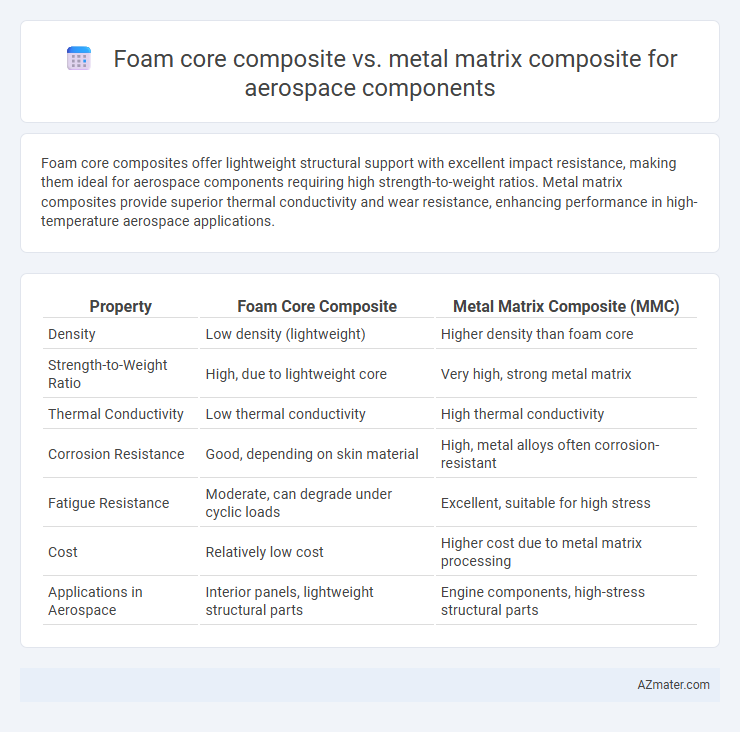Foam core composites offer lightweight structural support with excellent impact resistance, making them ideal for aerospace components requiring high strength-to-weight ratios. Metal matrix composites provide superior thermal conductivity and wear resistance, enhancing performance in high-temperature aerospace applications.
Table of Comparison
| Property | Foam Core Composite | Metal Matrix Composite (MMC) |
|---|---|---|
| Density | Low density (lightweight) | Higher density than foam core |
| Strength-to-Weight Ratio | High, due to lightweight core | Very high, strong metal matrix |
| Thermal Conductivity | Low thermal conductivity | High thermal conductivity |
| Corrosion Resistance | Good, depending on skin material | High, metal alloys often corrosion-resistant |
| Fatigue Resistance | Moderate, can degrade under cyclic loads | Excellent, suitable for high stress |
| Cost | Relatively low cost | Higher cost due to metal matrix processing |
| Applications in Aerospace | Interior panels, lightweight structural parts | Engine components, high-stress structural parts |
Introduction to Aerospace Composite Materials
Foam core composites offer high strength-to-weight ratios and excellent energy absorption, making them ideal for aerospace structures requiring lightweight yet durable materials. Metal matrix composites (MMCs) combine metal alloys with ceramic reinforcements to achieve superior thermal stability, wear resistance, and mechanical strength under extreme aerospace conditions. Both materials enhance aircraft performance by addressing specific design challenges such as weight reduction, corrosion resistance, and structural integrity.
Overview of Foam Core Composites
Foam core composites consist of a lightweight foam core sandwiched between composite or metal face sheets, offering high stiffness-to-weight ratios crucial for aerospace structures. These composites provide excellent thermal insulation, impact resistance, and energy absorption, making them ideal for aircraft interior panels, radomes, and control surfaces. Their customizable core densities and cell sizes enable tailored mechanical properties to meet specific aerospace performance and weight reduction requirements.
Fundamentals of Metal Matrix Composites
Metal Matrix Composites (MMCs) consist of a metal matrix reinforced with ceramic or fiber materials, offering superior strength-to-weight ratios, thermal stability, and wear resistance ideal for aerospace applications. Compared to Foam Core Composites, MMCs provide enhanced mechanical properties such as higher stiffness, improved fracture toughness, and better high-temperature performance, critical for structural aerospace components. The fundamental advantages of MMCs lie in their tailored microstructure that optimizes load transfer between matrix and reinforcement, improving fatigue life and enabling lightweight, durable aerospace structures.
Weight Efficiency: Foam Core vs Metal Matrix
Foam core composites offer superior weight efficiency compared to metal matrix composites, significantly reducing the overall mass of aerospace components while maintaining structural integrity. The low density of the foam core reduces weight without compromising stiffness, making it ideal for applications requiring high strength-to-weight ratios. In contrast, metal matrix composites provide enhanced mechanical properties and thermal resistance but generally incur a weight penalty due to the higher density of metallic constituents.
Mechanical Strength and Durability
Foam core composites exhibit high strength-to-weight ratios and excellent energy absorption, making them ideal for aerospace components requiring lightweight durability. Metal matrix composites (MMCs) offer superior mechanical strength, enhanced wear resistance, and increased thermal stability, outperforming foam core composites in high-stress aerospace environments. The choice between foam core and MMCs depends on application-specific demands for strength, fatigue resistance, and operational temperature ranges.
Thermal Conductivity and Heat Resistance
Foam core composites offer low thermal conductivity, providing excellent insulation and heat resistance, which is critical for aerospace applications requiring lightweight materials that minimize heat transfer. Metal matrix composites (MMCs) possess significantly higher thermal conductivity due to their metallic constituents, enabling efficient heat dissipation in components exposed to extreme temperatures and thermal cycling. The choice between foam core composites and MMCs depends on the specific thermal management requirements, with foam cores favoring thermal insulation and MMCs excelling in heat resistance and conduction.
Corrosion Resistance in Aerospace Applications
Foam core composites exhibit superior corrosion resistance compared to metal matrix composites due to their non-metallic core materials and protective resin layers, significantly reducing susceptibility to environmental degradation in aerospace applications. Metal matrix composites, while offering excellent mechanical strength and thermal conductivity, are more prone to corrosion, especially when exposed to moisture and aggressive chemicals common in aerospace environments. Selecting foam core composites enhances long-term durability and lowers maintenance costs for aerospace components operating under harsh atmospheric conditions.
Manufacturing and Processing Techniques
Foam core composites are typically manufactured using sandwich construction techniques involving resin infusion or vacuum-assisted resin transfer molding (VARTM), offering lightweight structures with excellent stiffness-to-weight ratios ideal for aerospace panels. Metal matrix composites (MMCs) require powder metallurgy, casting, or diffusion bonding processes to achieve superior thermal resistance and mechanical strength, which are essential for high-performance aerospace components exposed to extreme environments. The complex processing of MMCs results in higher production costs and challenges in achieving uniform reinforcement distribution compared to the more straightforward fabrication of foam core composites.
Cost Analysis and Lifecycle
Foam core composites offer significant cost advantages in aerospace components due to lower raw material and manufacturing expenses compared to metal matrix composites (MMCs), which involve high-cost metals and complex fabrication processes. Lifecycle cost analysis indicates foam core composites provide weight savings that reduce fuel consumption and maintenance costs over time, whereas MMCs deliver superior mechanical properties and thermal resistance, justifying higher upfront investment in extreme operating environments. Selecting between the two depends on balancing initial budget constraints against long-term performance requirements and durability in aerospace applications.
Future Trends in Aerospace Composite Materials
Foam core composites offer lightweight structures with high stiffness-to-weight ratios, ideal for reducing the overall mass of aerospace components, while metal matrix composites provide superior thermal resistance and mechanical strength critical for high-temperature engine parts. Future trends in aerospace composite materials emphasize multifunctional capabilities, combining structural integrity with embedded sensors and self-healing properties to enhance safety and durability. Advanced manufacturing techniques such as additive manufacturing and nanomaterial integration are driving innovation in both foam core and metal matrix composites, optimizing performance for next-generation aerospace applications.

Infographic: Foam core composite vs Metal matrix composite for Aerospace component
 azmater.com
azmater.com